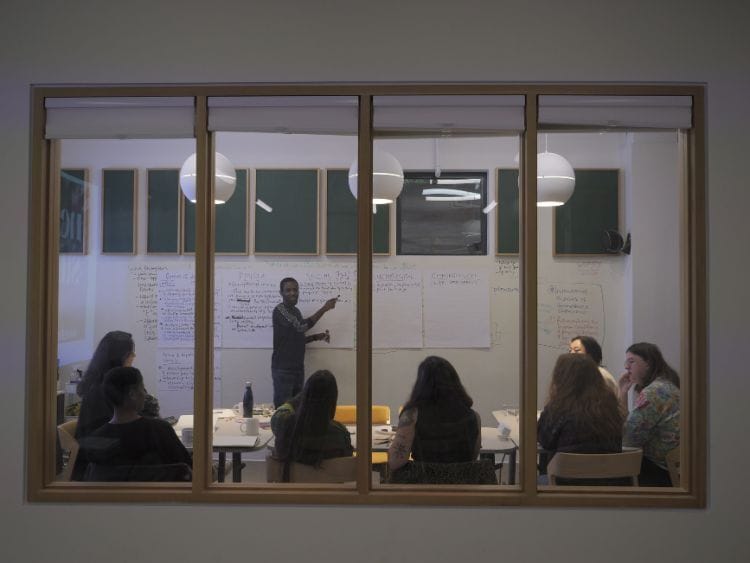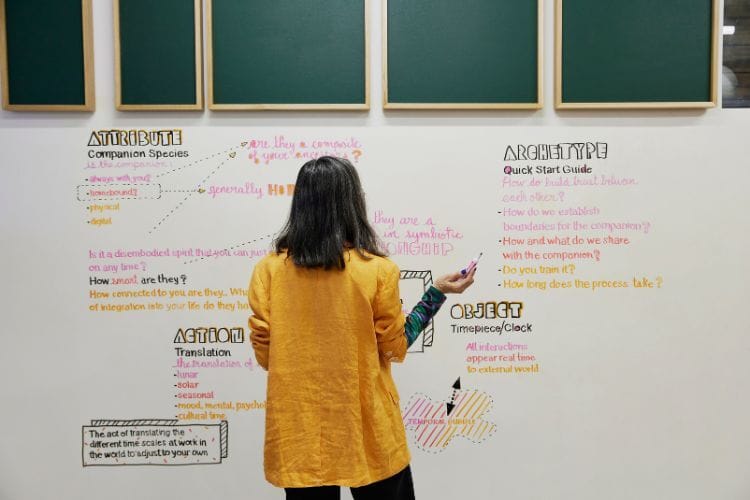At Artengine, mixing technology with art isn’t just a side-practice—it’s a tool for reimagining our very futures.
Since first launching in 1996, Artengine, located inside the Arts Court at 2 Daly Ave., has been a home for Ottawa’s experimental creatives. As a ‘futurelab’, the organization has spent almost three decades bringing together artists, designers, technologists and researchers to explore the social impact of emerging technologies. This is not your average group of artists.
Managing director Remco Volmer first moved to Canada from the Netherlands in 2000. At the time, Artengine was a small, volunteer-run organization. “The first staff wasn’t even hired until 10 years into its existence,” he says.
In 2008, Volmer began working with the Artengine team, producing the Electric Fields festival—an event showcasing experimental audio-visual performances. In the years since, he’s seen the organization transform repeatedly. “Roughly every five years, the focus of the organization changes,” he says. “That shift is almost a necessity, because new ideas and technologies bubble up.”
This constant evolution is what keeps Artengine on the cutting edge. From its early work with computing hardware and internet-based art, to live stage performances featuring light projection and sound manipulation, and then to laser cutting and 3D printing, Artengine has always embraced new tools to expand artistic possibilities.
Today, the team is exploring immersive technologies—artificial intelligence, virtual reality, and multisensory environments—to create thought-provoking exhibits tackling topics ranging from climate change to racial justice to urban design.
A space run by artists, for artists
Based in the Arts Court, Artengine boasts a sprawling, open-space performance area, a meeting room with a large screen, wall-to-wall white boards and lounge area, and a fully decked arts workshop space (you can see a tour of Artengine here).
Importantly and unlike more traditional art spaces, anyone can get involved with Artengine, the team is always open to meeting new creatives. “We’re rooted in ideas of open source and accessibility,” Volmer says. “At the core is the belief that technology is never neutral. It carries power dynamics based on who develops it, who has access, and who controls it.”

Audiences gather to watch the performance of traditional Iranian folk band, Rastak. Photo by John-Finnigan Lin.
Artengine’s mission, then, is to disrupt those dynamics through art. “We want to take these technologies out of the ‘mystical realm’,” says Volmer. “We want to show people how things work, to demystify the power structures behind them.”
One example of this ethos is Artengine’s ‘pirate interruption’ of YouTube algorithms. The team scraped Canadian cultural content from YouTube and built their own searchable database with full transcripts called the ‘CanCon AV Index’, making it easier for users to find videos by theme—such as Indigenous futurism—without being subject to opaque search engines that “don’t necessarily favour certain content,” Volmer says. “We were trying to interrupt algorithmic oppression,” Volmer says.
As well as public exhibits, Artengine is a hub for artist gatherings, hosting events like GroupChat, described as a ‘book club for artwork’, bringing people together to discuss everything from extended reality experiences to indie gaming.
From Saturday June 7, during Ottawa Doors Open and Pique, Artengine will unveil ‘New Suns’: a major project rooted in speculative fiction, running for two weeks. Over the past year, the team hosted a residency for eight artists across Canada. Guided by sci-fi author and Nebula-awards finalist Suyi Davies Okungbowa, artists were encouraged to imagine humanity’s future. The residency culminates in a collaborative ‘biopunk’-inspired exhibit that unpacks the implications of biotechnology.
Highlights of the upcoming showcase include a futuristic sculpture by Melanie Barnett, a ceramist from Medicine Hat, a meditative sound installation paired with a futuristic rocking chair by Victoria-based artist, Kemi Craig, and a bioprinter printing biological materials, created by Dr. WhiteFeather Hunter: an internationally recognized, award-winning Canadian artist and PhD researcher.
Dr. Hunter’s bio-printer has been picked up for conferences in Slovenia and France. “That’s an amazing result from this project already,” Volmer says.
Another 30 years of Artengine
Next year is Artengine’s 30th anniversary. As the arts sector grapples with post-pandemic instability and shrinking budgets, Volmer sees this moment as a call to action rather than a retreat. “Even in uncertain or fearful times, the arts have an essential role in how we live together and how we see ourselves—individually and collectively,” he says.
Looking ahead, Artengine plans to double down on its commitment to community, accessibility, and imagining better futures. “We want to ask: how do we make a beautiful life for ourselves that isn’t extractive, but grounded in empathy, care, and respect?” Volmer asks.
For Volmer, that question is at the heart of Artengine. “Art is a system of care,” he says. “It allows us to model and build better worlds, even if temporarily. That work is more important than ever.”
Nickie Shobeiry is a freelance journalist covering arts and culture, and an award-winning filmmaker (you can find her work on CBC and Bell). Find Nickie’s website here.




